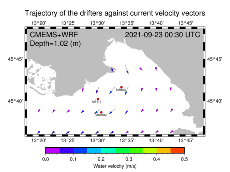Questo sito è in fase di dismissione. Consultare il nuovo sito www.arpa.fvg.it
#FIRESPILL: ARPA FVG (PP 11) ha attivato gli Stokes Drifter MetOcean e condotto i primi test nel Golfo di Trieste
Nell'ambito del progetto Interreg IT-HR FIRESPILL [1], sono stati condotti da ARPA FVG [2] i primi test sul funzionamento degli Stokes Drifter forniti dalla ditta MetOcean [3] . I drifter sono dispositivi che, trasportati dalle correnti marine superficiali, tracciano periodicamente la loro posizione permettendo di calcolare la traiettoria seguita e la velocità dello spostamento.
Dopo l’attivazione, si è verificato il loro corretto funzionamento conducendo delle prove nel Golfo di Trieste. In particolare, il rilascio dei dispositivi è stato effettuato in tre punti (SMNU3,ME111 e Mambo3) considerati funzionali allo studio della diffusione di possibili inquinanti all’interno del golfo. In contemporanea, si è proceduto alla previsione delle loro traiettorie tramite il modello GNOME, utilizzando diverse fonti per i determinanti ambientali. Dopo tre ore dal rilascio gli Stokes Drifter sono stati rintracciati e catturati con successo. Si è verificata una buona corrispondenza tra le traiettorie previste dal modello e le misure eseguite dai Drifter.
I tre Stokes Drifter, sono stati acquisiti appositamente per la validazione dei modelli di oil spill pyGNOME, GNOME e Medslik-II, in fase di implementazione operativa presso l’ARPA FVG.
L'obiettivo è quello di migliorare le previsioni sulla diffusione di un inquinante oleoso in ambiente marino, in conseguenza allo sversamento accidentale dello stesso, contribuendo così al raggiungimento della deliverable D.4.3.1, collocata all’interno del progetto pilota "Oil spills and other marine hazards".
As part of the Interreg IT-HR FIRESPILL [1] project, ARPA FVG [2] conducted the first set of tests on the Stokes Drifters, which are supplied by the company MetOcean [3]. Drifters are devices that are transported by sea surface currents and they periodically mark the position, allowing the calculation of the trajectory they follow together with the speed of the movement.
After the drifters activation, operational tests were carried on in the Gulf of Trieste. In particular, the devices were released in three points (SMNU3, ME111 and Mambo3) which are considered functional for the study of the spread of oil pollutants within the gulf. At the same time, their trajectories were predicted by GNOME model, using different forecasted environmental conditions. Three hours after release, the Stokes Drifters were tracked down and successfully captured. There is a good agreement between the trajectories provided by the model and the measurements performed by the Drifters.
The three Stokes Drifters have been acquired by ARPA FVG specifically for the validation of the pyGNOME, GNOME and Medslik-II oil spill models, in their operational implementation phase.
The goal is to improve forecasts on the diffusion of a pollutant in the marine environment, as a consequence of its accidental spillage, thus contributing to the achievement of deliverable D.4.3.1, located within the pilot project "Oil spills and other marine hazards ".
Riferimenti - References












